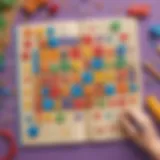Engaging Group Games for Active Elementary Children


Intro
Children thrive when they engage in interactive group games. These activities not only ensure physical exercise but also promote vital social skills and cognitive development. This guide focuses on a variety of fun, active group games best suited for elementary school children, ranging from ages 5 to 12. Each game offers unique benefits, drawing children into teamwork, strategy, and simple enjoyment.
Creative Activities
Creative activities are essential in keeping children engaged and fostering their imagination. They provide a platform for self-expression and often encourage group collaboration.
Craft Ideas
Craft ideas are plentiful and can easily be tailored to suit a variety of settings. Simple projects like making friendship bracelets or creating collages from recycled materials allow children to work together toward a common goal. These activities do not require extensive materials but evoke creativity and teamwork among peers.
Step-by-Step Guides
To execute a successful craft activity, follow these step-by-step guides:
- Friendship Bracelets: Supply children with thread. Teach them basic knot-tying techniques. Start with a simple braid or weaving.
- Collage Projects: Gather magazines, scissors, and glue. Allow kids to cut out pictures and words. They can then assemble anything meaningful to them on a large sheet of paper.
Educational Value
Engaging in these creative crafts offers educational benefits such as improving fine motor skills, enhancing listening ability, and aiding in teamwork. The process requires focus and decision-making, which are important cognitive skills.
“Creative play helps to unlock a child's imagination while building essential skills.”
Fun Quizzes
Fun quizzes can be a playful way to reinforce learning along with the enjoyment of teamwork and competition.
Quiz Topics
Topics for quizzes can be varied, ranging from science facts, geography, and reading comprehension to history. By tapping into diverse subjects, these quizzes maintain children’s curiosity and interest.
Question Types
Use different question types such as multiple-choice, fill-in-the-blank, or true/false. This mix keeps children engaged and curates a deeper understanding of the quiz topic.
Knowledge Reinforcement
Quizzes serve as an excellent method for reinforcing knowledge. When children participate together, they not only share answers but also discuss concepts, adding to their understanding and retention of information.
Fact-Based Articles
Fact-based articles present informative and engaging content to elementary schoolers. When linked with group games, they become a resource for enriching children’s play experiences.
Topics
Diffеrent topics covered can include unusual animal behaviors, interesting historical events, or fun experiments at home. Exposing children to such knowledge encourages exploration and questions.
Engaging Content
Engagement is about simplifying complex topics so that the information is digestible and enjoyable for children. Using clear headings, bullet points, and simple vocabulary makes reading less intimidating.
Intro to Active Group Games
The concept of active group games occupies a significant place in the realm of childhood education and development. These games serve as more than mere entertainment for elementary school children aged five to twelve; they are foundational experiences providing multifaceted benefits crucial for growth. In a world increasingly dominated by screens and sedentary activities, embracing active group games re-affirms the necessity of physical engagement in early childhood.
Participating in group games encourages children to move their bodies, making physical fitness an enjoyable endeavor rather than a chore. The ethos of mobility exists deeply in these games, relating particularly to the natural instincts of play and exploration.
Moreover, active group games promote essential soft skills such as teamwork, dependability, and communication. Each child learns to collaborate with peers, negotiate roles, and understand the importance of cohesive participation to achieve shared objectives. Day-to-day school interaction, through games, shapes future social competence.


Interestingly, the cognitive aspects of playing active group games are often overlooked. Children strengthen critical thinking and problem-solving skills when engaging in strategized games that require foresight and adaptability.
Research shows that physical activity, linked to group games, stimulates cognitive development and enhances performance in academics.
Furthermore, active group games present a platform where all children can belong and thrive, regardless of physical abilities. The inclusivity induced by structured play is beneficial for honing emotional intelligence and self-regulation skills.
In our command exploration of various forms of play across different setups, understanding these games' essence allows educators and parents to tailor engaging scenarios, thus integrating vital lessons in a compact, dexterous format. This article dedicates itself to illustrating these critical elements while providing guidelines related to engaging safely and wisely. The benefits abound — let us explore this dimension fully.
The Importance of Physical Activity for Children
Engaging in physical activity is crucial for the overall development of children. Active group games play a pivotal role in not just providing fun, but also promoting a well-rounded spectrum of benefits. This section highlights these various advantages, further emphasizing their relevance in education and development for elementary school children.
Physical Benefits
Participating in group games supports healthy growth and prosperity. Physical activity helps children build strength and stamina. Activities help maintain a healthy weight and improve cardiovascular health. Key physical benefits include:
- Bone Development: Weight-bearing activities strengthen bones, reducing the risk of fractures.
- Muscle Strength: Games involving running, jumping, or throwing help in developing strength and coordination.
- Endurance: Regular activities boost endurance, allowing children to engage in various tasks without getting easily tired.
- Expressing Energy: Children have higher energy levels. Engaging in games allows them to expend it positively, preventing behavioral issues.
Mental Benefits
Physical activity greatly impacts cognitive function. Research illustrates that physical engagement can lead to improves in focus and attention. Consider the following:
- Enhanced Concentration: Tasks that involve movement help in developing attention span. Children tend to perform better in class following active playtime.
- Stress Reduction: Games provide an escape from academic pressures, allowing children to unwind and manage stress effectively.
- Cognitive Development: Tasks often require quick thinking and problem-solving which enhances overall cognitive abilities.
- Confidence Boost: Mastering new skills or participating in a team contributes to self-esteem. This raises the likelihood of continuation and success in future endeavors.
Social Benefits
Participating in group games fosters social growth among children. They learn to communicate effectively and develop partnerships. Social benefits encompass:
- Teamwork: Group activities instill the importance of collaboration. Teamwork teaches children to work towards common goals.
- Communication Skills: Children learn to articulate and express themselves well in a cooperative setting, which can carry over into other areas of life.
- Conflict Resolution: Games often involve minor conflicts. Learning to navigate these disagreements shapes important conflict resolution skills.
- Building Friendships: Engaging in games helps establish connections among peers, contributing to long-lasting friendships and support systems.
Selecting Appropriate Games for Age Groups
Selecting the right games is crucial for engaging elementary school children in activities that suit their developmental needs. By recognizing various stages of childhood growth, educators and parents can tailor games effectively. Proper selection can enhance enjoyment, participation, and learning. This section delves into understanding development and game complexity to ensure that chosen activities promote physical fitness and cognitive skills effectively.
Understanding Developmental Stages
A key factor in game selection is a child's developmental stage. Young children, aged 5 to 7, enjoy simpler games that allow for exploration and movement. They might struggle with complex rules, thus opting for straightforward activities becomes beneficial. For children aged 8 to 10, they tend to seek more structure and collaboration with peers. At this age, children can better understand rules and participate in strategy-based games. Lastly, children aged 11 to 12 have developed critical thinking and endurance, allowing them to engage in the more physically demanding and competitively oriented games.
In assessing developmental stages, consider these points:
- Physical Maturity: Younger children usually have less coordination. Choose games conducive to gross motor skills development.
- Cognitive Abilities: The ability to follow multi-step instructions grows with age. Tailor activities according to their understanding.
- Social Skills: Children older than 8-year show interest in teamwork. Games that require small group collaboration serve this need well.
Game Complexity
Once developmental stages are recognized, attention to game complexity becomes important. The rules, physical involvement, and skills required must balance engagement and challenge. For younger kids, simple structure invites participation without overwhelm. Classic games like 'Duck Duck Goose' hold appeal without confusion.
As children grow, they can tackle slightly more complex games. Here are factors defining game complexity:
- Rules: Complex rules may discourage younger children. Select games with limited rules for younger groups and gradually introduce nuance.
- Strategy: Older children should benefit from strategy-based play. Game dynamics can include roles or decision-making elements—as seen in game variations like 'Capture the Flag'.
- Physical Demand: All games should cater to the level of physical activity appropriate for age. Always adjust the energy level according to each child's satisfaction that encourages play while still prioritizing safety.
Playing age-appropriate games accommodates children’s evolving physical and cognitive abilities.
Outdoor Group Games
Outdoor group games play a vital role in the daily activities of elementary school children. These games facilitate not only physical exertion but also teamwork, cooperation, and skills like strategic thinking. Being outdoors elevates the engagement levels. The fresh air and natural environment can significantly enhance children's mood and social interactions. Through these games, children outgrow common sedentary habits and learn life lessons through play.
Tag Variations
Tag variations remain a popular choice for outdoor games. The central objective is simple: one player is designated as ‘it’ and must chase other players to tag them. Once tagged, players typically switch roles. Different forms of tag can add depth and variation. For instance, implementing specific zones or modifying rules can keep the game evolving and interesting. Children would benefit from practicing agility, speed, and dexterity.
Among these variations, Freeze Tag stands out, where tagged players must freeze until another player releases them. This format encourages teamwork as players must strategize how to save frozen friends without getting tagged themselves. Or perhaps Shadow Tag, where players can't just tag someone but must touch their shadow, adding an element of spatial awareness.


Scavenger Hunts
Scavenger hunts leverage both exploration and problem-solving skills, often becoming commendable favorites among groups. The premise is to create a list of items or challenges that players must find or complete within a designated area, often a playground or local park. This game engages children's observation skills, enhances focus, and promotes healthy competition.
You can ease in the element of education by incorporating themes, like a nature scavenger hunt. Here, items such as specific leaves, rocks, or even shapes can be targeted. Varied themes not only entertain but improve the knowledge and information retention of children. Encourage creative thinking by allowing kids to develop their scavenger hunt lists too, amplifying ownership of the activity.
Relay Races
Relay races can morph typical outdoor play into instructional sessions. This game segregates players into teams. Each participant races to a designated point, completes a task, and returns to pass a baton or signal the next player. Such races boost cardiovascular health through running, but also instill values of fairness and perseverance in young learners. Everyone gets a chance to participate, while they improve their individual and team effort.
Various challenges can be intertwined into such races. Gymnastic tasks or obstacle navigations can be alternated to make every race unique. Using unorthodox tools like frisbees or balls can also convert a straightforward relay into an immersive experience.
Capture the Flag
Capture the Flag stands out as one of the quintessential outdoor games. Its adaptive nature allows modification to group size, enabling sparse teams or larger congregations. This game focuses on capturing the opposing team's flag while protecting your own. It draws attention to strategy as players must find ways to secure their own flag with stealth while attempting to invade the opposing territory. The open field also presents an opportunity for children to test their physical capabilities.
Playing this game enhances decision-making and challenges participants' ability to work cohesively. It often becomes a memorable event and can grow competitive, in turn fostering resilience and the understanding of winning gracefully and losing with dignity. Safety must always remain a prime focus however, so limiting the play area and having adult supervision is advisable.
These outdoor activities bind social relationships and cement friendships that strengthen personal development in children while allowing their energies to manifest positively.
Indoor Group Games
Indoor group games serve as a practical solution for providing physical activity and engagement when outdoor options are limited. These games encourage cooperation, creativity, and critical thinking while utilizing limited space effectively. With the educators and caregivers aiming for fun activities that can be quickly organized, indoor games also help in managing large groups, ensuring all children are included and active. The benefits are diverse, ranging from improvement in social skills to better emotional regulation, which makes these activities worthwhile. Here are some popular choices:
Simon Says
Simon Says is a classic game that captivates children while enhancing their listening skills and focus. The rules are simple. One player, designated as
Team-Based Games
Team-based games play a crucial role in elementary school children's development. They encourage collaboration and communication. These activities provide students with the opportunity to work together towards a common goal. This cooperation builds friendships and a sense of belonging. Kids learn essential social skills such as sharing, supporting peers, and resolving conflicts. The various team-based games have different merits, creating diverse experiences for the players that can meet various needs and preferences.
Dodgeball
Dodgeball is a classic game and is highly favored by many children. It is an engaging option that fosters teamwork as players rely on one another to avoid being hit by the ball. It encourages agility and quick reflexes since players must dodge incoming balls while also attempting to hit opponents. This active engagement requires strategy, ensuring teams work effectively together.
Key Benefits of Dodgeball:
- Enhances physical endurance
- Promotes tactical thinking
- Encourages communication within teams
Dodgeball requires some health and safety measures, considering players could face injuries. Proper supervision and appropriate space are necessary to conduct the game safely. Plus, using foam balls helps minimize risks.
Kickball
Kickball combines elements of baseball and soccer. The game is simple and effective for promoting teamwork. Participants can easily understand the concepts of scoring and teamwork through the act of running, kicking, and catching the ball. This game emphasizes teamwork as players field and defend accordingly. When playing kickball, kids experience strategic plays, as they cooperate to upend the opponent.
Key Benefits of Kickball:
- Improves coordination
- Aids in physical fitness development
- Notes importance of teamwork and strategy
Encouraging healthy competition can lead to disputes. Setting rules beforehand can assist in reducing conflicts among teammates. Kickball matches can serve as moments for recognition and celebration of achievements together.
Sports Trivia Games
Sports trivia games incorporate cognitive skills within team activity. Kids answer questions based on various sports, enhancing their knowledge. Trivia fosters discussion, allowing collaborative sorting of answers through conversation and negotiation. Sports trivia can serve as a peaceful and engaging alternative to the broader physical activity spectrum while still requiring teamwork.
Key Benefits of Sports Trivia Games:
- Reinforces teamwork through group problem-solving
- Provides learning moments about sports history
- Expands general knowledge of sports and players


Setting up sports trivia can take place anywhere. Organizing breaks in-between traditional physical games fosters varied engagements.
This combination of active and cognitive games supports children's growth, meeting varied developmental needs some students may have during their elementary years.
Games for Large Groups
Games for large groups are essential in providing dynamic and engaging experiences for elementary school children. When children gather together, the interaction expands beyond the game itself. In this context, large group games facilitate teamwork, communication, and the development of social skills. Additionally, such games influence engagement levels, promoting inclusivity among all participants.
The physical space and diversity are also notable factors in considering games for large groups. Often in a group setting, a more significant area is required to play, demanding careful planning and organization. The following sections delve deeper into the two particular options: team challenges and obstacle courses.
Team Challenges
Team challenges are excellent for promoting cooperation and a sense of community among players. These activities encourage participants to rally together to achieve a common goal, fostering a spirit of unity. When children collaborate, problem-solving skills sharpen, and a competitive but friendly atmosphere can be created.
Consider organizing structured activities like a human knot or treasure hunts that require strategic planning and communication. In these scenarios, children have to discuss and strategize to succeed, tapping into their innate capabilities for teamwork. It can also serve as a platform to foster leadership qualities among participants. Activities should be inclusive for various skill levels, ensuring every child can contribute.
The key to successful team challenges is finding a balance between challenge and achievement. When children succeed as a group, their morale increases, greatly benefiting their confidence.
Obstacle Courses
Obstacle courses present a fantastic opportunity for children to engage in physical activity while testing their agility and strength. They can be designed for any scale, from simple items like cones to elaborate setups that include tunnels and climbing structures. This flexibility allows them to be intricate or straightforward, depending on the appropriate age and skill levels.
The benefits of obstacle courses are significant. They promote gross motor skills, enhance coordination, and allow children to participate in a low-stress, competitive environment. You can assess both physical fitness and social engagement while maintaining the excitement in a group setting.
Additionally, incorporating elements of teamwork can further add value to obstacle courses. Teams can be formed to excel at overcoming challenges as a unit rather than individually. This approach doesn't merely enhance physical activity, it boosts self-esteem and cultivates long-lasting friendships among participants.
Large group games such as these can create educational and enjoyable experiences. The rules should be clear, and supervisory guidelines must be visible to ensure a safe atmosphere.
Safety Considerations in Group Games
Understanding and addressing safety considerations in group games is essential. These considerations ensure that all participants have fun while minimizing risk. This section explores key areas to think about when organizing games for elementary school children, including the need for proper supervision and thorough environment assessments.
Supervision Guidelines
Effective supervision is vital in fostering a safe game environment. Adults should actively oversee activities to prevent accidents and injuries. A trusted adult leader or coach must lead the group. The following are important guidelines for effective supervision:
- Ratio of supervisors to children: Maintain a limited number of children per adult to assure attention.
- Designated zones: Set clear game areas where play occurs, out of the way from hazards like traffic or construction
- Training for leaders: Supervisors trained in child development and first aid can handle safety needs swiftly. Their knowledge helps them to proactively manage situations.
- Clear communication: Establish signals or rules for stopping play immediately if necessary. Expect children to follow them.
By following these guidelines, adult supervisors can effectively safeguard children during active games.
Environment Assessment
Assessing the environment prior to play is a necessary part of ensuring safety. This involves inspecting in detail the game area to identify potential hazards. Important considerations in this assessment include:
- Surface checks: Inspect the ground. Clear any debris or objects that may cause tripping or falling.
- Security evaluation: Ensure that boundaries are well defined and free from any distractions or threats.
- Weather conditions: Before outdoor games, assess weather conditions to avoid extremes that may cause risk, like thunderstorms or extreme heat.
- Emergency access: Familiarize with exit routes and understand first aid availability.
Performing a thorough environment assessment helps to predict and meet safety challenges before they become real issues. It embodies a proactive approach and allows for adjustments to be made immediately for safety.
End: The Role of Group Games in Education
Playing group games holds immense value in the educational journey of elementary school children. These games are not merely ways to spend time; they serve as essential tools for learning. Here, we highlight some important aspects of group games and their role in education.
First, group games foster teamwork and collaboration. When children engage in games together, they learn the significance of working with others toward a common goal. This experience cultivates relationships and helps develop communication skills, resonating well in both academic and personal settings. As children negotiate rules or decide strategies, they build social skills necessary for everyday interactions.
Second, such games encourage physical fitness. Through active play, children become familiar with their bodies and develop coordination, balance, and overall stamina. This becomes increasingly important as we see a trend of sedentary lifestyles among youth. When kids play outdoor games like Capture the Flag or relay races, they not only have fun, but they are also active, often without realizing they are exercising.
On another note, group games have mental benefits. Team-based or strategic games push children to engage with concepts like critical thinking and problem-solving. When engaging in games like sports trivia or Dodgeball, kids formulate plans or react swiftly, training their brains to process information much faster. This cognitive engagement is a crucial element of learning.
Moreover, educational group games also instill resilience and sportsmanship. Winning is often sweet, yet learning to cope with failure is equally valuable. Children cultivating appropriate responses to loss prepare for life's challenges. They learn to appreciate effort over victory.
The potential of group games shines during group projects or class-based activities, providing a sense of agency. Kids feel motivated knowing their contributions can significantly impact the outcome. This sense of control boosts their self-esteem.
In evaluating the importance of group games in schools, it's clear that they enrich the educational experience beyond the mere transmission of knowledge. Group games blend physical, social, and cognitive development remarkabley, which is fundamental in forming well-rounded individuals. Thus, it becomes vital for educators and parents to incorporate these games into children’s routines.
Incorporating fun active group games into children's daily routines reinforces not only physical development, but also enduring social and cognitive skills.
To summarize, group games offer more than entertainment. They play an impressive role in forming children's character and enhancing essential life skills vital for the future. It is where learning, playing, and socializing converge, creating an optimum environment for educational growth.







